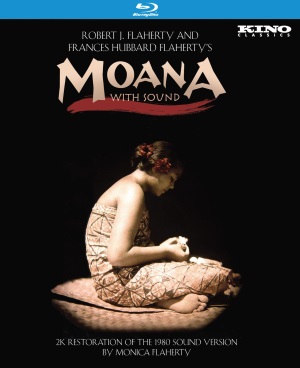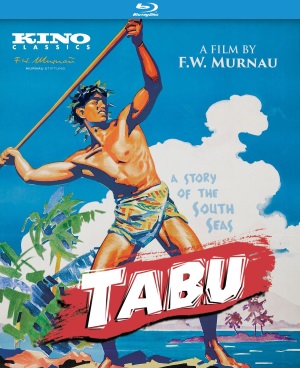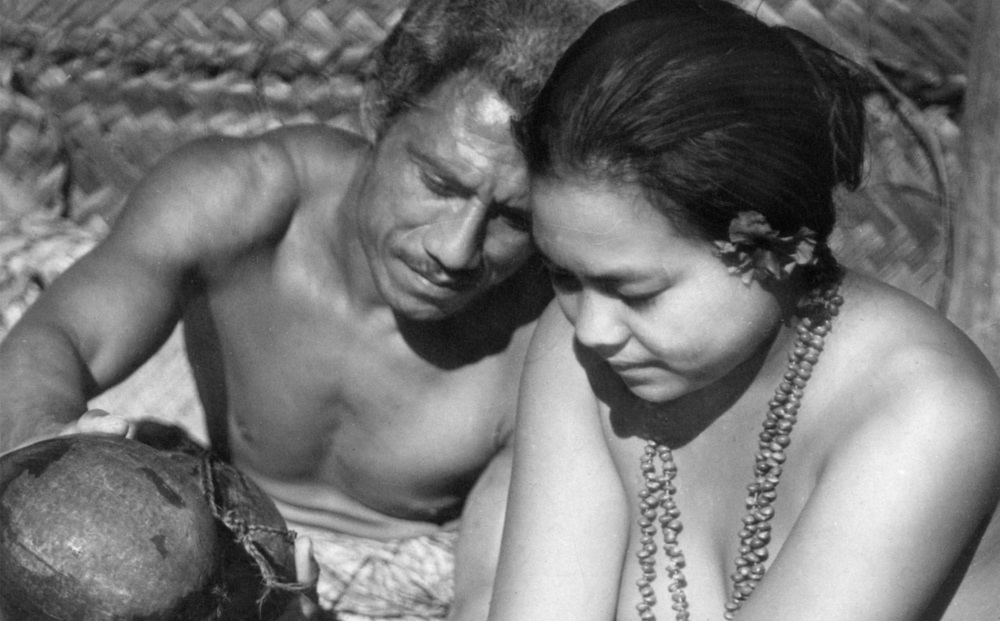 Moana with Sound (Kino Classics, Blu-ray, DVD) – After creating what (in retrospect) is generally considered the first documentary feature, Nanook of the North, in the snows of northern Canada, filmmaker Robert Flaherty traveled to the South Seas island of Savai’i to create a similar production around the Polynesian natives. Like Nanook, Moana (1926) is not a true documentary record but a recreation of a long lost culture for the cameras created in collaboration with locals, who draw from their own historical memory. And it was the film that inspired the term “documentary,” which film critic (and later documentary producer) John Grierson coined while reviewing the film.
Moana with Sound (Kino Classics, Blu-ray, DVD) – After creating what (in retrospect) is generally considered the first documentary feature, Nanook of the North, in the snows of northern Canada, filmmaker Robert Flaherty traveled to the South Seas island of Savai’i to create a similar production around the Polynesian natives. Like Nanook, Moana (1926) is not a true documentary record but a recreation of a long lost culture for the cameras created in collaboration with locals, who draw from their own historical memory. And it was the film that inspired the term “documentary,” which film critic (and later documentary producer) John Grierson coined while reviewing the film.
Moana is a poetic portrait of Polynesian life as an South Seas paradise, the opposite of Nanook, where the Inuit people fight to survive the harshness of the elements. The pace of life is easy and gentle in the Pacific sun, food plentiful in the sea and growing all around them, just waiting for anyone—even a child—to pluck the coconuts off the trees. Hunting and gathering is akin to play in this culture that was, again as in Nanook, long lost by the time Flaherty put his camera on these people. His filmmaking reflects the theme, each scene taking its time to play out, not to record every detail of finding fresh water in a branch, climbing a palm tree with a simple woven band wrapped around the ankles, or hunting a wild boar (the only real threat to human life on the island), but to appreciate the grace with which these activities are accomplished. The gentleness of the filmmaking—which was as painstakingly created for the camera as any Hollywood drama—creates a lovely, luscious film, a great leap forward in Flaherty’s cinematic talent.
The film was of course silent but Robert and Frances Flaherty (his wife was very much a partner on the project despite her lack of credit) wanted to accompany the film with the music and songs (especially “the singing,” as Frances remarked back in 1926) of the people. So in 1975, their daughter Monica traveled back to Savai’i with documentary legend Richard Leacock to record a soundtrack, not just music but sound effects and dialogue in the regional dialect, for a rerelease of the film. (Lip readers helped determine what was being said and a script created from that.) The sound was added to a copy of the film and Moana With Sound released in 1980, but the version of the film available to Monica Flaherty at the time was not accurate to the release version and featured worn imagery generations away from the original negative. This new restoration, produced by Bruce Posner and Sami van Ingen, restores the film from the best existing elements and marries the soundtrack (also cleaned up with new digital tools) to the superb imagery of the restoration. Some damage and wear can be seen in brief sequences but for the most part the film looks amazing.
Blu-ray and DVD with the new 40-minute featurette “Moana With Sound: A Short History” with Bruce Posner (who produced this restoration) and the shorter “About the Restoration” (also with Posner), two very informative productions debuting with this release, and filmed commentaries by historians Enrico Camporesi and Bruce Posner. Archival extras include Flaherty’s 1925 short film Twenty-Four-Dollar Islands, the 1960 interview with Frances Flaherty “Flaherty and Film: Moana,” and Flaherty home movies.
 Tabu (Kino Classics, Blu-ray, DVD) was begun by Robert Flaherty in collaboration with German émigré F.W. Murnau, who wanted to revisit the culture of Moana as a backdrop for his own dramatic ideas. Sensibilities clashed and Flaherty left the film, leaving Murnau to create his own vision of Paradise Lost in the story of young lovers (Mathai and Reri) threatened by tribal law. Murnau uses the clash of cultures to contrast an Eden-like innocence with the corruption of modern society (one seemingly sensitive white soul is more opportunist than romantic). The mythic undertones are more European than Pacific Rim and Murnau’s portrayal of the young lovers as Peter Pan-like children of nature is paternalistic at best and downright condescending in parts. But Tabu is also astoundingly beautiful, like a B&W rendering of Paul Gauguin’s visions of Tahiti through an expressionist sensibility. This is classic Murnau, a powerful, poetic story of the doomed struggle against fate, and his final film. He was killed in a car accident just a week before the film premiered.
Tabu (Kino Classics, Blu-ray, DVD) was begun by Robert Flaherty in collaboration with German émigré F.W. Murnau, who wanted to revisit the culture of Moana as a backdrop for his own dramatic ideas. Sensibilities clashed and Flaherty left the film, leaving Murnau to create his own vision of Paradise Lost in the story of young lovers (Mathai and Reri) threatened by tribal law. Murnau uses the clash of cultures to contrast an Eden-like innocence with the corruption of modern society (one seemingly sensitive white soul is more opportunist than romantic). The mythic undertones are more European than Pacific Rim and Murnau’s portrayal of the young lovers as Peter Pan-like children of nature is paternalistic at best and downright condescending in parts. But Tabu is also astoundingly beautiful, like a B&W rendering of Paul Gauguin’s visions of Tahiti through an expressionist sensibility. This is classic Murnau, a powerful, poetic story of the doomed struggle against fate, and his final film. He was killed in a car accident just a week before the film premiered.
Shot as a silent film, it was released with a synchronized soundtrack with a score (called a “musical setting” in the credits) by Hugo Riesenfeld, preserved for this restoration by the Friedrich-Wilhelm-Murnau-Stiftung.
Blu-ray and DVD with the short documentary “The Language of Shadows,” a German language featurette on the making of the film and this new restoration that the institute produced, and the featurettes “Tabu: Takes and Outtakes” and “Tabu: A Work in Progress,” which present some of the unused footage shot by Murnau for the film with narration in German with English subtitles. Also includes Hunt in the South Seas (1940), an ethnographic short film created from unused footage from Tabu.
Calendar of upcoming releases on Blu-ray, DVD, Digital, and VOD

